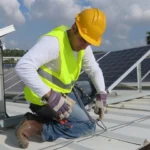A well-designed sign is only as effective as its installation. Whether it’s an eye-catching storefront sign or informative interior signage, professional sign installation is essential to ensure durability, visibility, and compliance with local regulations. The placement and installation process can significantly impact how a sign communicates with its audience and contributes to a brand’s success.
This article delves into the importance of professional sign install services, the steps involved, and how they enhance the effectiveness of your signage.
Why Professional Sign Installation Matters
While design and materials are critical to a sign’s performance, proper installation ensures it delivers its intended impact.
Key Benefits of Professional Installation
- Optimal Visibility
Professional installers strategically position signs to maximize visibility and engagement. This includes selecting the right height, angle, and location based on foot traffic and viewing distance. - Safety and Stability
Improperly installed signs can pose safety risks, such as falling or collapsing in adverse weather. Professionals use secure mounting techniques and durable materials to prevent accidents. - Compliance with Regulations
Local codes often dictate the size, height, and placement of signs. Professional installers ensure compliance, avoiding fines and the need for costly adjustments. - Longevity
Proper installation protects signs from damage caused by environmental factors, extending their lifespan and maintaining their appearance.
By investing in professional services, businesses ensure that their signs are functional, safe, and impactful.
The Sign Installation Process
Professional sign install services follow a systematic approach to ensure precision and quality.
Step 1: Site Evaluation
Installers begin by assessing the installation site to determine the best placement for the sign.
- Factors Considered:
- Visibility from key vantage points.
- Structural integrity of walls, poles, or other mounting surfaces.
- Proximity to utilities or power sources for illuminated signs.
A thorough site evaluation ensures the sign meets both aesthetic and practical goals.
Step 2: Preparing the Area
Before installation begins, the site is prepped to ensure a clean and secure foundation.
- Surface Cleaning: Dirt, dust, or debris is removed to ensure proper adhesion or mounting.
- Structural Reinforcement: Weak surfaces are repaired or reinforced to handle the weight of the sign.
- Power Setup: For illuminated signs, wiring and power sources are inspected and prepared.
This step sets the stage for a seamless and durable installation.
Step 3: Mounting the Sign
The mounting process varies based on the type and location of the sign.
- Wall-Mounted Signs: Anchors or brackets are used to attach the sign securely to walls.
- Pole Signs: Signs are affixed to poles with sturdy brackets, ensuring they remain stable even in strong winds.
- Hanging Signs: Ceiling mounts or chains are used to suspend signs safely.
Installers use specialized tools and techniques to ensure precision and safety during this phase.
Step 4: Testing and Adjustment
After the sign is mounted, professionals conduct a series of tests to confirm its functionality and appearance.
- Alignment Check: Ensures the sign is level and positioned correctly.
- Illumination Test: For lighted signs, bulbs or LEDs are tested to ensure proper brightness and consistency.
- Structural Integrity: Mountings are inspected for stability and durability.
This step guarantees that the sign meets quality standards and is ready to perform.
Types of Sign Installations
Signage comes in various forms, each requiring unique installation methods to achieve maximum effectiveness.
1. Outdoor Signage
Outdoor signs are exposed to weather conditions, making proper installation crucial for durability and visibility.
- Monument Signs: Installed at ground level, often requiring concrete bases for stability.
- Channel Letters: Mounted on building facades, these signs often include illumination for nighttime visibility.
- Pylon Signs: Tall, freestanding signs that require reinforced bases to withstand wind and weight.
Professional installation ensures outdoor signs remain attractive and functional despite environmental challenges.
2. Indoor Signage
Indoor signs serve a variety of purposes, from branding to wayfinding.
- Wall Graphics: Applied with precision to avoid bubbles or wrinkles.
- Dimensional Letters: Mounted with standoffs or adhesives for a sleek, professional appearance.
- Directional Signs: Positioned strategically to guide visitors efficiently.
Accurate placement enhances the effectiveness of indoor signage and complements interior design.
3. Temporary Signs
Temporary signs, such as banners or event displays, require flexible installation methods that allow for easy removal.
- Freestanding Frames: Portable and reusable, ideal for trade shows or seasonal promotions.
- Window Decals: Installed with adhesives that allow for clean removal.
- A-Frames: Simple to set up and relocate, perfect for sidewalk advertising.
Professional installation ensures that temporary signs are secure and visually appealing, even for short-term use.
Common Challenges in Sign Installation
Sign installation involves overcoming various challenges to achieve the desired outcome.
1. Weather Conditions
Extreme weather can complicate outdoor sign installations. Professionals use weather-resistant materials and techniques to address these challenges.
2. Structural Limitations
Older buildings or unconventional surfaces may require customized solutions for secure mounting.
3. Compliance Issues
Navigating local zoning laws and permitting requirements can be complex. Professional installers handle these aspects to ensure compliance.
The Importance of Partnering with a Sign Company
Working with an experienced sign company streamlines the installation process, providing peace of mind and superior results.
Why Choose Professionals?
- Expertise: Skilled installers understand the nuances of different sign types and environments.
- Advanced Equipment: Access to tools and technology ensures precision and efficiency.
- Post-Installation Support: Professionals offer maintenance and repairs to keep signs in top condition.
DesignElement Raleigh offers comprehensive sign install services, combining technical expertise with an eye for detail to ensure your signage delivers maximum impact.
Maintenance Tips for Installed Signs
Regular maintenance prolongs the life of your signs and keeps them looking their best.
- Clean Periodically: Remove dirt and grime with appropriate cleaning agents.
- Inspect for Damage: Check for loose mounts, fading, or cracks and address issues promptly.
- Replace Lighting Components: For illuminated signs, replace bulbs or LEDs as needed to maintain brightness.
Proper care protects your investment and preserves the effectiveness of your signage.
Conclusion
Professional sign installation is a critical step in creating impactful and long-lasting signage. From ensuring safety and compliance to maximizing visibility, expert installers play an essential role in bringing your signage vision to life.
Whether it’s outdoor, indoor, or temporary signage, partnering with a trusted sign company like DesignElement Raleigh ensures precision, durability, and outstanding results.


